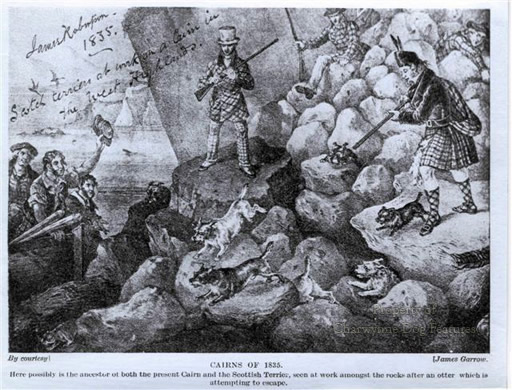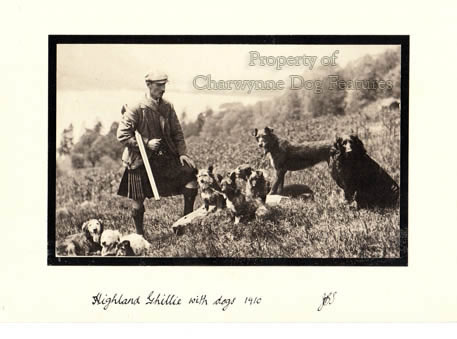687 WILL THE SPORTING TERRIER SURVIVE
WILL THE SPORTING TERRIER SURVIVE?
by David Hancock
“In old days anyone with a knowledge of sport and the characteristics required in a dog to enable him to act his part, was a judge; in these days to become a judge of a breed one must commit to eye and memory a number of exaggerated peculiarities the use of which are unapparent. No doubt these points are all based on characters which were found to be essential to the old working dog, but they have been so exaggerated by the fancier that their original use in a modified form is often entirely lost sight of. No doubt the present craze will wear itself out in time, and we may hope some day for the re-establishment, with the assistance of reversion, of the old-fashioned useful, if less ornamental dog.”
Those words were written by the knowledgeable CJ Davies in his informative The Kennel Handbook of 1905, but his concern was justified and, sadly, apply as much today as when they were written. There are quite a number of terrier breeds listed by the Kennel Club as ‘sporting terriers’ that have no right whatsoever to bear that descriptive adjective. Times change but the errors continue.
Not many terrier owners of today could match the claim of Sir Jocelyn Lucas, the famous sporting terrier breeder, who when recommending Sealyhams for sport, once wrote: “In the Ilmer kennel every inmate is regularly shot over from four months old. The whole pack can be, and are, taken out and worked together, a feature which would be impossible in the majority of kennels. No fighter would be tolerated an instant. They will work with hounds, whippets, or a gun, and they are good in water. This strain will go anywhere, tackle anything, and they have their tails up as soon as they can crawl.” The question to ask the terrier owner of today, even in these much-changed times, may well be ‘Why keep a terrier if it is quite unable to be one?’

Throughout our social history as a nation, changing attitudes have influenced our use of dogs in the name of sport. Barbaric activities like badger, bear and bull-baiting, rat-killing competitions and dog-fighting contests have rightly been outlawed. Nevertheless, we still prize and perpetuate that one-time canine gladiator, the Bull Terrier, even if some legislators retain the view that once a fighter always a fighter. Bull Terrier fanciers need reminding that their dogs were sporting dogs in the field long before they were used in the pits. They should perpetuate their breed as a sporting terrier not as a role-less gladiator; a working test could so easily be devised to retain their sporting spirit. The spirit behind trail-hound matches and Whippet racing, the Bloodhound packs which hunt a human trail, lure-chasing with Irish Wolfhounds and even nocturnal rat-catching in a maggot-factory, as the renowned sporting terrier breeder, the late Brian Plummer recommended, provides such encouragement for the future of sporting dogs. Perhaps, sadly, the single-issue lobbyists may have them too in their sights.
As fewer and fewer dog breeders take part in activities involving field sports, the functional aspect of their breed's anatomy can be lost sight of, and that is not good for any breed, sporting ones especially. No sporting dog can triumph in the field without the physique needed for the sport concerned; as country sports are curtailed the challenge is to retain the working model not the prettiest one. The best dog show judges retain a concept of a breed's purpose in the ring; their critiques sometimes make disturbing reading. One recent critique from a Lakeland Terrier show made the comment that it should be the fox that runs away from the Lakeland, not the other way round! The 2010 Crufts judge in Glen of Imaal Terriers observed in a long valuable critique: “I have to register concerns about the way the breed seems to be going.” Seven years earlier, the Glen of Imaal Terrier judge at Crufts found..."quite a few weak jaws and that would never do in my view for what they were originally bred for." At Crufts in 2001, the Bedlington Terrier judge reported "some lacked the bone and substance required in a working terrier." The 2009 Crufts judge remarked on Sealyhams: “Rear movement was a major concern to say the least.” And the Fox Terrier judge reported: “I was disappointed to see so many heavy heads…Movement was also bad in a lot of cases.” The Parson Russell Terrier judge commented: “Poor movement is still very much in evidence, with plaiting, paddling and a general lack of coordination.” The Irish Terrier judge concluded: “Movement in general was disappointing, looseness in front and lack of drive behind…” The Cairn Terrier judge was concerned that some males had very poor heads and heavy bone, expressing worry over the lack of good quality stud dogs. The Border Terrier judge stated: “Shoulders still need attention with many severely lacking layback, and, of more concern some foreleg assemblies are placed too far forward, so forechests are vanishing. This produces flashiness but it is wrong.” A year earlier, the Fox Terrier judge reported: “The quality of exhibits in males was disappointing.” It is extremely worrying that our top dog show should reveal such flaws in sporting terrier breeds. Flawed pedigree terriers still cost a great deal to buy - and even more to treat.

Dog lovers who pay £500 for a pedigree terrier pup and expect it to hide its sporting instincts and behave like a Toy breed are not engaging their brains. Terriers have an instinct to dig, to explore drains, to hunt small furry creatures and to display a combative nature. If you want a happier terrier, you need to be conscious of their innate yearnings, their inherited longings. Bored frustrated terriers can end up digging where you just don’t want them to, expending pent-up energy by chasing your neighbour’s cat and barking, just to relieve tension. Let them hunt a hedgerow, explore a shrubbery, race around the park – be active! You’ll have a happier terrier as a direct result – and almost certainly, a happier life. Terriers are essentially sporting dogs; they deserve our empathy. Some sporting terrier breeds like the Skye and the Sealyham may well fade from view through sheer lack of support, with fewer than 100 being registered each year.
If our sporting terrier breeds are to survive there has to be a planned renaissance, not a mute acceptance of the status quo, not an abrogation of responsibility for breeds we specifically bred and developed over several centuries to assist us in the sporting field. It would be a major step forward if show breed clubs took up this challenge, although I suspect that the shallow show-ring pursuit of rosettes has more appeal for them. Just as the United Kennel Club in the United States fathers a wide range of field activity for terriers, so too could our own Kennel Club, extending their field trial and agility interest. Sporting organisations too could diversify their sporting agenda, in the interests of the dogs alone, if only to have the canine ingredients of a rebirth one day, should field sports regain wider legal acceptance. To neglect the best interests of sporting dogs would be shameful. Positive thinking is called for, not intellectual collapse.
For a nation which has given the world a score of distinguished sporting terrier breeds, many of them preferred to foreign native breeds on sheer merit, we must now work to ensure that all the dedicated work of our forefathers is not thrown away. Sporting terriers must be bred to the design for their time-honoured function as earth-dogs; if we do not respect their origins we will destroy many long-established much-admired terrier breeds, not just by neglect or indifference but from being arrogant enough to attempt their redesign on false criteria. Scottish Terriers do not need ground-hugging coats, Sealyham Terriers do not benefit from heads like boot-boxes or the Fox Terrier from a front assembly which denies it forward reach. Their locomotion should not be so impaired in the shorter-legged breeds that they end up moving like canine millipedes. They should not ‘carry a leg’, as so many Jack Russells do, because of knee problems. The Bull Terrier does not deserve to be the only breed of dog with a rugger-ball for a head. Skye Terriers should not resemble floor-mops and Airedales should not be soppy ornaments. Terriers are very special dogs; they are very much Britain’s contribution to the canine world. Their perpetuation must not be wallet-led but based on their distinguished sporting heritage, illustrated by their breed names alone: Norfolk, Cairn, Fox, Parson Russell, Lakeland, Bedlington and Sealyham; their survival as sporting dogs now merits our fullest attention.
We need to keep in mind the words of the old Cumbrian terrier song:
“Always remember your terriers,
Protect them from wet and cold,
For the love of a tyke for his master,
Can never be measured in gold.”